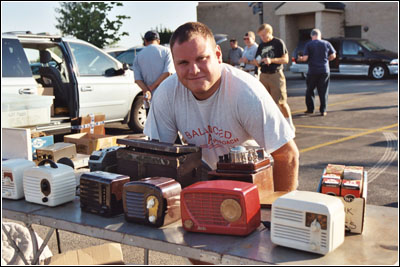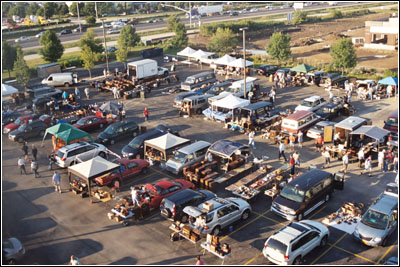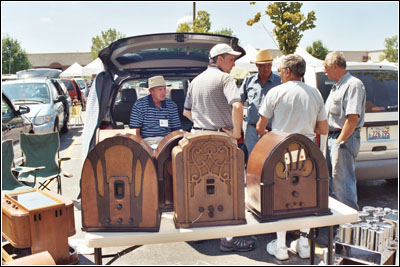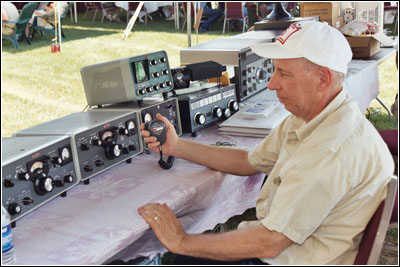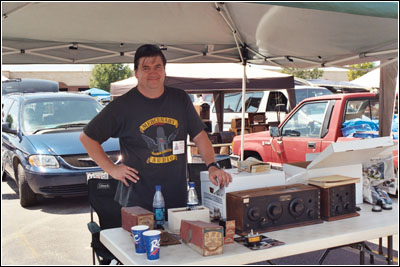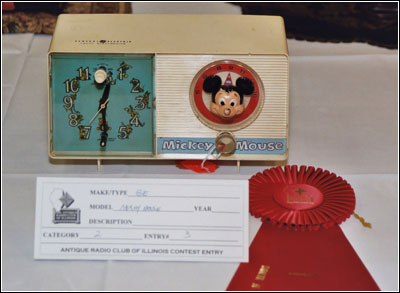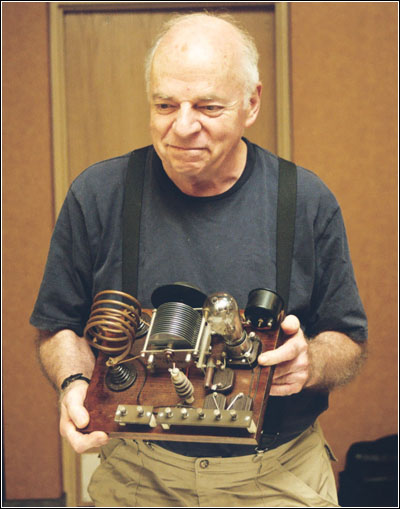Of Old Radios And Related Items--Published Monthly
Meet and Auction report
Antique Radio Club of Illinois
Radiofest XXV -- August 3-5, 2006REPORTED BY DANIEL SCHOO
Web Edition
The Antique Radio Club of Illinois (ARCI) held its annual Radiofest meet beginning Thursday August 3, 2006, at the Holiday Inn of Bolingbrook, Illinois. The hotel is conveniently located about 30 miles southwest of Chicago's O'Hare airport on Remington Road near the intersection of Illinois routes 55 and 53 with easy access from the metro Chicago area and suburbs.
A number of recommendations from last year were implemented including a more centrally located hospitality tent, improved signage and better layout of the flea market area to improve the traffic flow. These and other improvements made this year's event much more comfortable.
Radiofest officially started on Thursday afternoon with preregistration from 4 to 6 p.m. New this year was an opening party held outside on the grass near the hotel pool at 7 p.m. Approximately 70 people attended the party and were treated to free hors d'oeuvres and a cash bar. Everyone had a great time meeting and getting acquainted with fellow radio collectors.
Andy Schultz displays his midget radio offerings at the flea market.Flea market trading officially began on Friday morning at 7 a.m. The weather could not have been better -- partly to mostly sunny skies with highs in the mid-80s every day. This year 202 seller spaces were sold, about the same as last year. I was there at 6:30 a.m., and the activity was already brisk. The general public was welcome to come in for flea market shopping at no charge.
Registration was available beginning at 7 a.m. with Julia Bart and Judy Huether greeting sellers. The hospitality tent also opened at 7 a.m. hosted again this year by Janet and Jack LaVelle. Cold drinks, chips, some of Janet's homemade cookies, and a shady place to sit down were available, all for a goodwill donation. For lunch the hotel served hot dogs, burgers, fries and side dishes under the tent.
This view of the flea market shows the magnitude of Radiofest XXV.The special event Amateur station AR9CI, coordinated by Jim Novak, WA9FIH, began operation at 8 a.m. The station used all classic tube type equipment generously loaned for the occasion by Dale Svetanoff WA9ENA. Dale, along with Chris Farley, KC9IEQ and Ed Schumacher, WA9GQK, took turns operating. They made 32 contacts and special event QSL cards will be sent.
George Wilder did free radio appraisals again this year. The appraisal booth is a walk-up service for anyone who would like to know what a particular radio is approximately worth. This year 29 appraisals were done. We were very happy to have about 30 Boy Scouts participate again this year -- twice the number we had last year. Merit badges in "Radio" and "Collections" were earned.
On display at Ray Taylor's booth; left to right, a chairside radio, three cathedrals and an E.H. Scott chromed chassis.Chuck Schwark, assisted by Toni Blesy and Mike Bart, conducted the Radiofest antique equipment contest. There were 30 entries this year in the following categories: Commemorative, Character, Planes-Trains-Automobiles, Military, Pre-1930s, Cathedral, Tombstone, Transistor, Hidden, Speakers and Open.
An all day series of excellent one-hour programs began at 9 a.m. John Bart assisted the presentations by providing technical support for the computer-based multimedia system. Attendees numbered 35 to 50 at the discussions on four interesting topics.
Opening the day, Felicia Kreuzer and her son James presented a slide show about their collection of very early Marconi wireless equipment. Felicia and her husband Jim have a museum quality collection of Marconi wireless transmitters and receivers. She explained how and where pieces were acquired and related amusing anecdotes about finding and transporting rare and unusual old wireless gear.
Jerry Kolpa, WB9GTO, using some nice tube-type Collins gear to put Special Event Amateur Radio station AR9CI on the air.Because of the Kreuzer's Marconi knowledge, the Titanic Museum in Branson, Missouri, contacted them for help. The facility, then under construction, is a half scale reproduction of the famous Titanic ocean liner anchored in water to create the illusion of being at sea. For a historically accurate display, the museum sought to acquire genuine Marconi wireless equipment identical to what would have been used on the ship. Felicia explained how she and Jim had supplied equipment and worked with the museum staff to recreate the Titanic wireless room faithfully.
Charlie Stinger hosted a fascinating presentation about entrepreneur and businessman Powel Crosley, Jr. Charlie is a retired engineer who worked at Crosley radio station WLW. He told the history of Powel Crosley's growing up, his first businesses, and his fascination with anything automotive.
Jim Kreuzer holds forth at his booth.Crosley's business interest was drawn to the rapidly growing radio parts and manufacturing business. Radio station WLW followed in order to serve the market for radios. Charlie explained how WLW initially went on the air with a makeshift 50-watt transmitter. Always wanting more power, Crosley upgraded the transmitter several times, reaching 50 kilowatts in 1928. He petitioned the government and received permission to upgrade WLW to 500 kilowatt operation. With this goal reached, he contracted RCA to design and build the world's largest transmitter.
Using numerous original photographs, Charlie discussed the construction of the transmitter and erection of the huge WLW broadcasting tower, which is still standing. The new transmitter officially went on the air in the spring of 1934. Charlie listed a number of interference problems it caused as far away as Canada. The 500 KW transmitter remained in regular service until March 1, 1939, when the semiannual renewal for the high power permit was denied. WLW and all other broadcasting stations were henceforth limited to 50 kilowatts by law.
Noted Zenith enthusiasts Alan Jesperson of Great Northern Antiques and Frank Rasada hosted a history of the Zenith Radio Company. A rare Zenith promotional film produced in the late 1920s showed the construction of a Zenith console radio. Beginning with the raw materials coming into the factory, everything involved with the construction was shown. The various departments all contributed to the manufacturing of electronic components, punching chassis parts, assembly line construction of the chassis, cabinetmaking and finally alignment and crating. Alan and Frank continued with the history of Zenith and the company's major accomplishments.
Mickey is always popular. T. W. Gifford's General Electric Mickey Mouse clock radio brought a 2nd prize in the Character category.For the final presentation, Marc Ellis explained the early spark gap days of Amateur radio around 1910. He related the story of how Hiram Maxim and Clarence Tuska founded the American Radio Relay League. He described and compared the basic vacuum tube oscillator circuits, such as the Hartley, Colpitts, Tuned Plate-Tuned Grid and Tuned Plate-Untuned Grid.
Marc explained that low power, one-tube Amateur radio transmitters using these circuits are built today using only parts and tubes that were available in the late 1920s. These transmitters are used in low power DX (long distance) Amateur radio contests. He displayed several samples to illustrate how assembly is done essentially in the same way as it would have been in 1930 using hand-wound coils and the old breadboard style construction.
Show and Tell time -- Marc Ellis holds a replica of a 1-tube transmitter. These transmitters, popular in the late 1920s and early 1930s, are still being built from old parts for use in old-time Ham radio contests.At noon Janet LaVelle again hosted the very popular annual Ladies Luncheon in the hotel restaurant at which 21 women were treated to door prizes and a raffle. Raffle items included a 1950s radio theme, print decorated, throw pillow and a porcelain figure. Janet also provided small gifts for everyone in attendance.
Friday evening the banquet opened with a cash bar and presentation of awards. There were 90 reserved seats this year. The President's Choice Volunteer of The Year Award went to Bill Smith for his outstanding work on the club newsletter for the last four years. The newsletter has undergone great improvements, and his work is greatly appreciated.
Steve Muchow and Chuck Schwark presented the Dr. Ralph Muchow Best of Show award to Tom Burgess for his 1942 Galvin Manufacturing (later to be Motorola) Models SCR511/BC745A "Pogo Stick" military radio display. Geoffrey Bourne received the People's Choice award for his display of an S.G. Brown Sphinx Model 991 speaker, made in the 1920s. Rounding out the evening, the Crown Vics, a retro-1950s style rock and roll band, gave a great performance.
On Saturday morning, many of the Friday flea market booths were still open. This year the main auction was moved outside to the hospitality tent for a more informal country auction atmosphere with about 60 people attending. The minimum opening bid was $25. Auctioneer Harry Blesy kept the bidding lively while Art Bilski and Chuck Schwark assisted with showing. There were 41 lots placed up for auction. Twenty lots were sold for a total of $825. Following the main auction a free auction sellers raffle was held.
The very popular donation auction followed the main auction. Over 30 bidders picked up bargains. I bought a colorful 1960s era store window U-Test-M "drug store tube tester" advertising poster in excellent condition. Displayed on the door to my office, it prompts a lot of comments.
Special thanks to everyone who helped make this event successful. As always ARCI is especially thankful for the program speakers who donated their time to share what they know about radio history. We are also grateful to the many people who attended and participated in the preservation of radio history by supporting our event. See print version of A.R.C. for complete auction listing.
Photos by Daniel Schoo.
© 2006 Daniel Schoo
(Daniel Schoo, 526 Colonial Drive, DeKalb, IL 60115)
The Antique Radio Club of Illinois (ARCI) publishes "ARCI Update" periodically and "ARCI News" monthly. Dues are $15. Events include the annual August Radiofest and bimonthly swap meets. For more information: clubinfo@antique-radios.org
A warning: Auction prices are not current values. Our selection of auction items is not necessarily complete. A listing such as this cannot adequately include the condition of cabinets, chassis, transformers, tubes, the operating status of the set, and the inclusion of incorrect, restored or replica components, etc. Auction prices are the result of the excitement of the auction process, the skill of the auctioneer and the specific interests of the participants. Nevertheless, auction prices serve as useful references and as another element in the value determining process. The possibility of error always exists, and if we are notified, corrections will be reported.
| [Free Sample] [Books, etc., For Sale] [Subscribe to A.R.C./Renew] [Classified Ads] [Auction Prices] [Event Calendar] [Links] [Home] [Issue Archives] [Book Reviews] [Subscription Information] [A.R.C. FAQ] URL = http://www.antiqueradio.com/Jan07_Schoo_ARC.html Copyright © 1996-2007 by John V. Terrey - For personal use only. Last revised: December 26, 2006. For Customer Assistance please contact ARC@antiqueradio.com or call (866) 371-0512 toll free Pages designed/maintained by Wayward Fluffy Publications
Antique Radio Classified |
